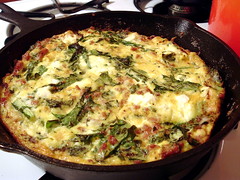
My apologies to Mr. Nabokov, who hopefully would have laughed at the sight of his prose — an enthusiastically scrambled tribute to it, at least — being retrogressively used to prod readers into cooking more rustic egg dishes. On a blog, at that.
There are several reasons to appreciate the frittata, the first being its ability to accommodate disparate vegetables hiding in corners of the refrigerator, an end of cheese reduced to a small pile of gratings, a single cold steamed potato, even half a cup of cold pasta that would otherwise be thrown away. In my experience, the longer one cooks, the greater one's pleasure in being thrifty, in not letting things go to waste. Particularly if one had plans for the produce in question — a bag of mixed lettuces that had been destined for a soufflé, until the Gruyère that was to stand in for the Cheddar accidentally got eaten, or a prodigious bundle of parsley that was to be used for a pot of green butter, which was in turn to be used to make little sandwiches. All of these things can go into a frittata, and the end result may be as harmonious as if you'd planned to use them for that purpose all along.

The second reason to appreciate the frittata is its versatility. It's great served warm from the oven, but just as nice at room temperature or even cold the next day. It can be cut into bite-size cubes and served as a snack with drinks, or it can be sliced and draped over a salad, or made into a sandwich.
The Silver Spoon, which has been referred to as "the Bible of Italian cooking" so often that my fingers type those words on their own, has, of course, instructive advice on frittatas. For starters, I had the plural wrong:
Italian omelets — frittate — are economical and quick and are among the tastiest dishes that can be made with eggs. They are also very versatile, as the basic recipe may be enriched and flavored with a wide range of other ingredients, including herbs, vegetables, fish, cheeses, salami, ham and fruit. As regards quantities, in general allow two eggs per person if the frittata is served as a main course and one if it is an antipasto. As a general rule, 1 1/2 teaspoons butter or olive oil is required to cook every two eggs.
The Spoon contemplates frittate thin enough to be flipped in the pan, and cooked on each side for just 1-2 minutes (or "2-3 minutes if there are more than four eggs"), but there are as many ways to prepare a frittata as there are cooks. If you are only using a few eggs, sure, flip it over in the pan, but if you are making a frittata that is more substantial, with half a dozen eggs or more and a pile of greens or who-knows-what, you must decide how to cook it through: Do you want to begin cooking it on the stove top and end with baking it in the oven, or do you want to mostly cook it on the stove top and just brown the top under the broiler? Are you determined to bake it in the oven for the duration of cooking? I've never tried the latter method and would be afraid it would dry out, since a frittata lacks the rich measure of cream that allows quiche to survive a long baking. I tend to make large frittate with 6-7 eggs and my method of choice depends both on what else I have cooking and what I've stirred into the eggs: If I have the oven heated up to 350-400°F for some other dish, I'll likely cook the frittata for 5-10 minutes on the stove, stirring occasionally with a wooden spoon or silicone spatula during the first two minutes to evenly distribute the ingredients, and then put it in the oven for approximately 10 minutes, or until it's set (i.e., no longer liquid in the center). If my frittata has grated cheese on top rather than stirred in with the other ingredients, I'll likely cook until it's almost set on the stove top, scatter the cheese on top, and put it under the broiler for just a minute. More often than not I use a method very similar to the scramble-and-broil method described by Pim (of Chez Pim) in this post, but I heat the olive oil over high heat and then do my almost-scrambling over medium or low heat, particularly if my ingredients are already warm or hot — adding just-sautéed greens, or crumbled and browned sausage, or any other ingredients that haven't cooled down will speed up the cooking time by a minute or two, and it's better to err on the side of undercooking rather than overcooking the eggs. You can always put the frittata into the oven for more cooking if you go to cut it and find that it's disconcertingly squishy under your knife. It should be firm but springy when it's done.
There's a way of flipping the frittata by inverting it on to a plate, but you've got to be sure that you have just the right size sturdy plate clean and ready to go at the crucial moment, and that you have two oven mitts handy, and what will you have gained? A cold oven. Useful on a hot summer afternoon, or if you are cultivating the carbon footprint of a saint, but otherwise it's hard to see what the advantage of that method is.
I was going to give four or five recipes for some of the best frittate we've had recently, but I didn't measure the ingredients for any of them. I never do. So, I'm just going to give you suggested combinations, followed by one recipe for what would be my favorite frittata of all, if it were a frittata and not a kuku.
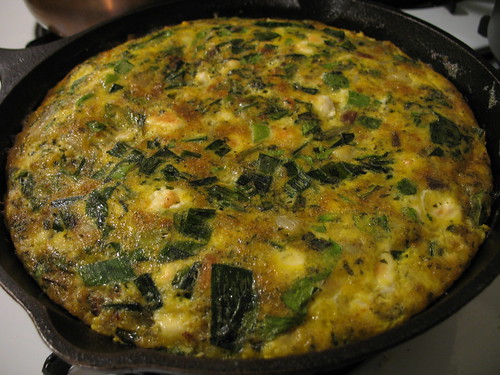
Ramps, spring garlic, scallions, feta cheese Despite my remarks above about the virtues of ransacking the refrigerator for bits of this and that, the best frittate are premeditated to some degree, hopefully while buying the eggs at the farmers' market. I wanted something special for a frittata made with the Araucana eggs I'd picked up, and I set aside bundles of the last ramps of the season, green spring garlic, and a few scallions (green onions), and 3-4 ounces of crumbled sheep and goats' milk feta cheese. I chopped the bulbs of the ramps and the spring garlic and sautéed them in a couple tablespoons of olive oil until they softened, added the chopped greens from all three alliums and sautéed them until they wilted, then added six eggs beaten with the cheese, salt, pepper and a bit of freshly grated nutmeg, and cooked as described above. The result was a golden frittata filled with a fragrant tangle of greens and soft, flavorful cheese.
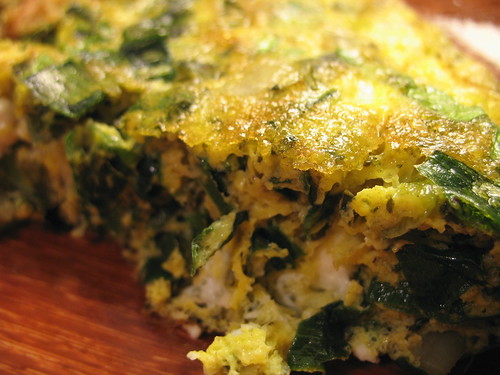
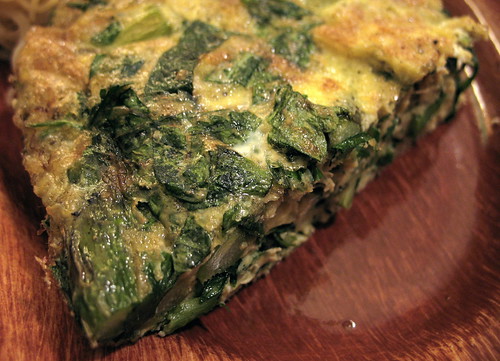
Asparagus, mint and tarragon There is something about the combination of eggs and mint that I can't imagine tiring of. Both mint and tarragon are strong flavors but somehow this worked. The asparagus can be steamed, blanched, or roasted as long as it is tender but still crisp. I chopped the asparagus into bite-sized pieces but if you have more patience for adorning your frittata you could neatly arrange the whole spears on the surface before it sets in the center.
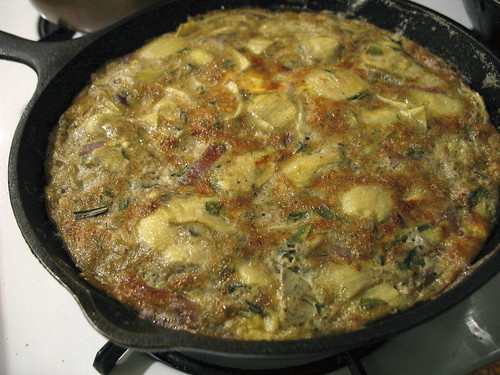
Artichoke hearts, red onion and rosemary I used artichoke hearts canned in water, which I rinsed under cold water and patted dry. You've got to be mindful about not adding too many wet ingredients to a frittata; otherwise it won't cook properly. For this reason, I tend to stay away from tomatoes unless they've been slow-roasted or otherwise dried out, or unless they're firm plum tomatoes. Once the artichoke hearts were reasonably drained, I chopped them into bite-size pieces and sautéed them, with chopped red onion, in a few tablespoons of olive oil until they started to brown. I added a tablespoon or so of chopped rosemary, then the beaten eggs, and cooked as described above.
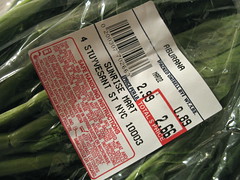
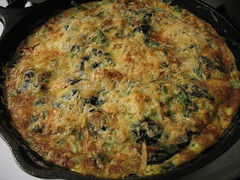
Aburana with grated Kashkaval cheese Kashkaval is a Bulgarian sheeps' milk cheese with a mildly tangy flavor. I thought it would pair nicely with the greens, which I found at the Japanese grocery in a bag labelled "Aburana." I thought they were dandelion greens but my Googling thus far indicates only that they might have been some type of rapini. I sautéed the greens in olive oil (with a sliced shallot and some red pepper flakes, if my memory is correct), added the eggs, and then added the grated cheese on top when the eggs were almost set; it melted nicely, and fast became crisp and browned under the broiler.
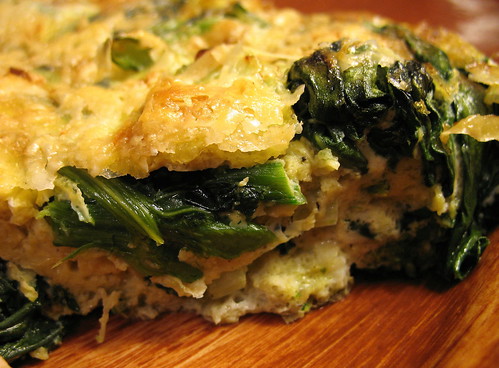
Kuku-ye Sabsi (pictured below) is an Iranian frittata-like dish traditionally made on New Years' Day. It's loaded with herbs, and the vibrant green color reflects hope that the year ahead will be a prosperous, happy, healthy one. I'm crazy about it and make it throughout the year, in the spring and summer with as varied a mix of herbs as possible, and in the winter with spinach and parsley and cilantro. The recipe below is from Claudia Roden's New Book of Middle Eastern Food. There's a similar recipe in the Boston Post which calls for currants rather than raisins; my guess is that in Iran it would be made with currants but they're not always easy to find, and it's great with raisins too. Roden indicates that the walnuts and the raisins are optional but I urge you to try the recipe with both, even if you are not a raisin person. I'm not, but the frittata that set me on the path to my frittata-enamored madness, years ago, was made with tuna and golden raisins and who-knows-what-else. I ate it at a tiny café in Lisbon on my way to Saint George's Castle, and I probably never would have ordered it had they had anything else to serve me but it turned out to be one of the most memorable lunches I've ever had.
Kuku-ye Sabsi
serves 6
6-8 eggs
4 ounces spinach, shredded
8 scallions, chopped
1/2-2/3 cup mixed chopped fresh herbs [In the note preceding the recipe Roden says "Any favored herbs, such as flat-leaf parsley, dill, chervil, tarragon, chives and cilantro, may be used."]
3 tablespoons chopped walnuts (optional)
2 tablespoons raisins (optional)
Salt and pepper
2 tablespoons butter or vegetable oil
Lightly beat the eggs with the rest of the ingredients except the butter or oil.
Grease an ovenproof dish (about 10 inches) with butter or oil and pour in the egg mixture. Bake in a preheated 325°F oven for 45 minutes, covering the dish for the first 25 minutes, until the eggs are firm with a golden crust on top. Alternatively, cook the kuku in a large preferably nonstick skillet. When the eggs have set on the bottom, brown the top under a hot broiler. [See my comments above for more details on this method of cooking. - TBC]
Serve hot or cold as a first course, accompanied by yogurt.
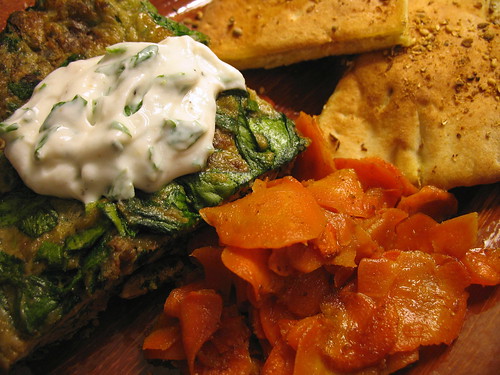
The best way to prepare the yogurt, in my opinion, is to start with good yogurt and set it to thicken in a sieve lined with a coffee filter, perched inside a bowl to catch the drips. (If you're doing this several hours ahead of time, cover the whole set-up with plastic wrap and put it in the refrigerator). Once the yogurt is nice and thick, blend in some chopped mint or cilantro and a pinch of salt, and maybe a tiny bit of minced garlic. Very good on leftover frittata or with toasted pita.
The frittata pictured at the top of the post was made with puntarelle, turkey sausage and ricotta cheese. I posted a recipe for it last August, which you can read here.




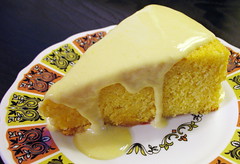
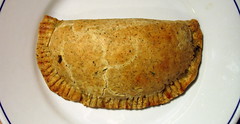


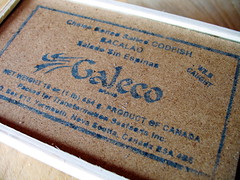

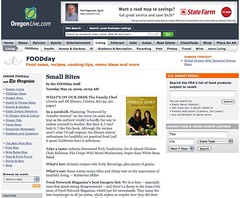



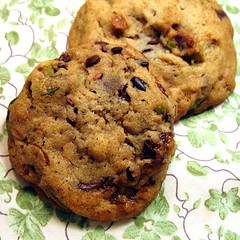

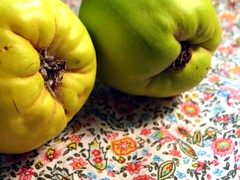
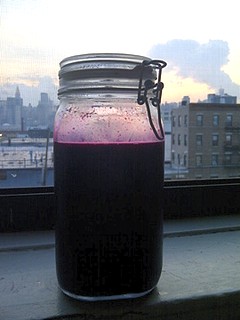
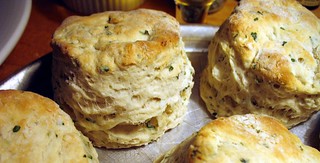
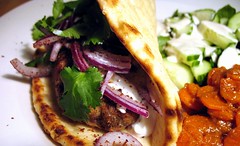
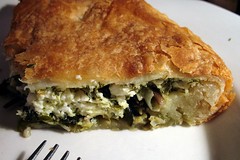


Aburana, that 's a new one for me though it sounds delish. And you're spot on about frittata--is there any definitive way to cook one? I don't think so. Each time I make mine (which I am wont to do when I have a bounty of veggies that are screaming to be eaten), my stove-top time and in-the-oven time varies--depending on a whole mess of factors I can't really qualify. But no matter, it's always good!
ReplyDeleteIt was lovely meeting you this evening--I wish I could have stayed longer to chat but alas work called. But I look forward to seeing you again soon!
It was fun meeting you too! We should have another one of these events somewhere outdoors this summer, maybe a picnic or BBQ -
ReplyDeletegreat recipe and blog - i think that dishes like Frittata are sorely underappreciated - despite the numerous delicious recipes out there, there's always scope for exporation - and that's what makes them great. As well as being delicious cold, also!
ReplyDeleteI just made my first kuku after reading this. It was great! You are right about the raisons adding extra goodness. I love how I got to use all of my green herbs. I'll be making this again.
ReplyDeleteStockton, thanks!
ReplyDeleteRachel, I'm so glad you tried kuku! I think this is the best time of year to make it, when there is such a variety of fresh herbs available.
I'm inspired! And I wish I'd read about tarragon/mint/asparagus frittata before I went to the farmer's market this morning. I stood looking at the last of the asparagus but decided against it. Now I'm regretting it.
ReplyDeleteJulie - Probably the same herbs would be good with zucchini? Hmm, I think there is a zucchini frittata in my future . . . .
ReplyDelete